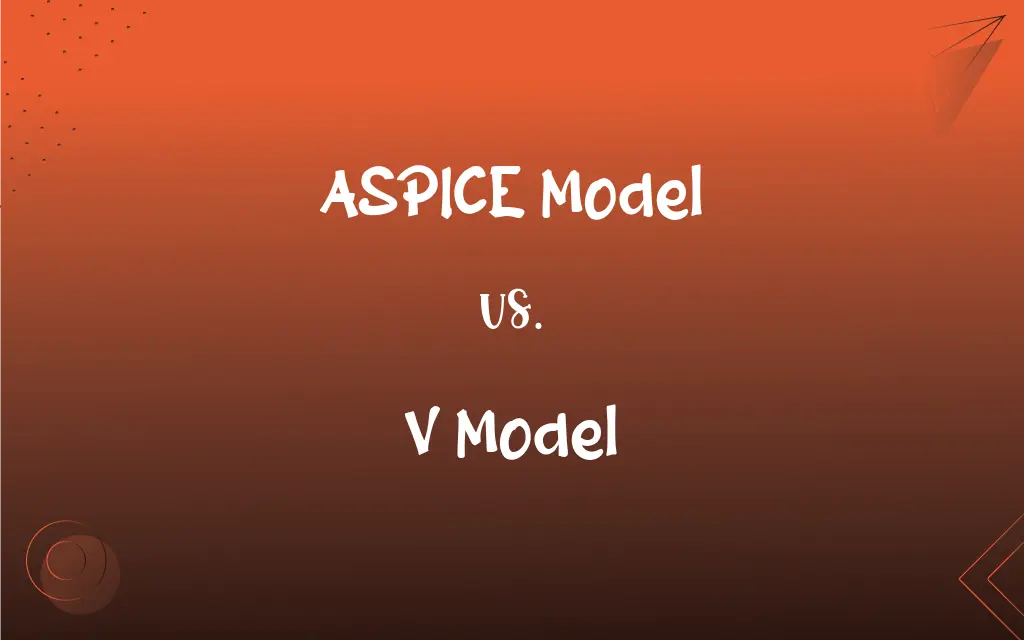ASPICE Model vs. V Model: What's the Difference?
Edited by Janet White || By Harlon Moss || Published on February 5, 2024
ASPICE Model is a process assessment model focusing on software development in the automotive industry, while the V Model is a software development model emphasizing validation and verification.

Key Differences
The ASPICE Model (Automotive Software Process Improvement and Capability Determination) is a framework designed specifically for software process improvement and assessment in the automotive sector. It focuses on defining, implementing, and evaluating software development processes. The V Model, on the other hand, is a general software development model used across various industries. It is known for its simple and linear approach, where each phase of development (e.g., requirements, design, implementation) is systematically followed by a corresponding testing phase.
In the ASPICE Model, emphasis is placed on aligning software development processes with international standards and industry-specific requirements. This model is crucial for ensuring quality and safety in automotive software. The V Model differs as it visualizes software development as a V-shaped process where development and testing phases are symmetrically aligned, underscoring the importance of validation and verification at each stage.
A key aspect of the ASPICE Model is its adaptability to the complex and specific needs of automotive software development, including compliance with safety and regulatory standards. In contrast, the V Model is more generic, suitable for a wide range of software development projects, and is recognized for its straightforward and predictable project management approach.
The ASPICE Model provides a detailed and structured approach to assessing and improving software process capabilities in automotive projects, offering a pathway to higher maturity levels. Whereas the V Model is predominantly concerned with the sequential execution of development phases, ensuring that each stage is thoroughly tested before moving on to the next, thus reducing the risk of project failures.
In terms of usage, the ASPICE Model is highly relevant in the automotive industry where software complexity and safety are paramount. It provides a comprehensive framework for managing software development processes. The V Model, being more generalist, is appreciated for its simplicity and clarity in various software development environments, not limited to any specific industry.
ADVERTISEMENT
Comparison Chart
Primary Focus
Process improvement in automotive software development
Validation and verification in software development
Industry Specificity
Specific to the automotive industry
Applicable across various industries
Model Structure
Assessment framework for process capability
Linear and sequential development phases
Emphasis
Compliance with safety and regulatory standards
Systematic testing corresponding to each phase
Applicability and Usage
Used for complex automotive software projects
Suitable for a wide range of software projects
ADVERTISEMENT
ASPICE Model and V Model Definitions
ASPICE Model
A process assessment model for automotive software development.
The company implemented the ASPICE Model to enhance their automotive software processes.
V Model
A software development model emphasizing validation and verification.
They used the V Model to ensure thorough testing at each development stage.
ASPICE Model
Automotive-specific model for software process management.
The ASPICE Model was crucial in managing the complexity of their automotive software project.
V Model
A development model where each phase is tested before moving to the next.
The V Model helped them identify issues early in the development process.
ASPICE Model
A guideline for aligning automotive software processes with international standards.
Through the ASPICE Model, they achieved compliance with global automotive software standards.
V Model
A linear approach to software development with corresponding testing phases.
The project's success was attributed to the structured approach of the V Model.
ASPICE Model
Framework for improving software process in the automotive sector.
Adopting the ASPICE Model helped them meet rigorous industry standards.
V Model
A sequential model for software development and testing.
Following the V Model, they systematically progressed from requirements to maintenance.
ASPICE Model
A tool for evaluating software process capability in automotive software.
Their ASPICE Model assessment resulted in significant process improvements.
V Model
A straightforward framework for managing software projects.
Their team appreciated the clarity and predictability of the V Model.
FAQs
What is the ASPICE Model?
It's a process assessment model for automotive software development.
What is a key feature of the ASPICE Model?
Its emphasis on safety and regulatory compliance in automotive software.
Can the V Model be used in any industry?
Yes, it's applicable across various software development industries.
Is the ASPICE Model industry-specific?
Yes, it's specifically tailored for the automotive industry.
What makes the V Model distinctive in software development?
Its systematic approach to testing after each development phase.
In what context is the ASPICE Model most relevant?
It's most relevant in complex automotive software projects.
What does the V Model focus on?
The V Model focuses on validation and verification in software development.
Is the ASPICE Model used for process improvement?
Yes, it's used to improve and assess software processes in automotive projects.
Is the V Model considered simple to implement?
Yes, due to its clear and predictable structure.
What is a benefit of using the V Model?
Early identification of potential issues in the development cycle.
Does the ASPICE Model align with international standards?
Yes, it helps align automotive software processes with global standards.
Can the V Model be adapted to different software methodologies?
It's most effective with methodologies that support linear progression.
Is training required to implement the ASPICE Model?
Yes, proper understanding and training are essential for effective implementation.
How does the V Model structure software development?
It follows a linear and sequential approach with corresponding testing phases.
What is the primary advantage of the V Model's testing approach?
Ensuring that each development phase is rigorously tested before proceeding.
Does the ASPICE Model have a global reach?
Yes, it's recognized globally in the automotive industry.
How does the ASPICE Model enhance automotive software quality?
By providing a structured framework for process assessment and improvement.
Is the V Model suitable for small projects?
Yes, its straightforward approach is suitable for projects of various sizes.
Can the V Model reduce project failure risks?
Yes, by ensuring thorough testing at each development stage.
Who benefits from using the ASPICE Model?
Automotive software developers and engineers.
About Author
Written by
Harlon MossHarlon is a seasoned quality moderator and accomplished content writer for Difference Wiki. An alumnus of the prestigious University of California, he earned his degree in Computer Science. Leveraging his academic background, Harlon brings a meticulous and informed perspective to his work, ensuring content accuracy and excellence.
Edited by
Janet WhiteJanet White has been an esteemed writer and blogger for Difference Wiki. Holding a Master's degree in Science and Medical Journalism from the prestigious Boston University, she has consistently demonstrated her expertise and passion for her field. When she's not immersed in her work, Janet relishes her time exercising, delving into a good book, and cherishing moments with friends and family.







































































